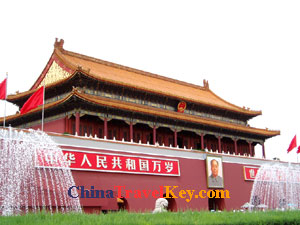Tiananm en
rostrum was first built in 1417 and named Chengtianmen (the Gate of
Heavenly Succession). At the end of the Ming Dynasty, it was seriously
damaged by the war. When it was rebuilt under the Qing in 1651, it was
renamed Tiananmen, and served as the main entrance to the Imperial
City, the administrative and residential quarters for court officials
and retainers. The southern sections of the Imperial City wall still
stand on both sides of the Gate. en
rostrum was first built in 1417 and named Chengtianmen (the Gate of
Heavenly Succession). At the end of the Ming Dynasty, it was seriously
damaged by the war. When it was rebuilt under the Qing in 1651, it was
renamed Tiananmen, and served as the main entrance to the Imperial
City, the administrative and residential quarters for court officials
and retainers. The southern sections of the Imperial City wall still
stand on both sides of the Gate.
Architecture:
The tower at the top of the gate is nine-room wide and five-room deep.
According to the Book of Changes, the two numbers nine and five. When
combined, symbolize the supreme status of a sovereign.
Function:
During the Ming and Qing dynasties, Tiananmen was the place where state
ceremonies took place. The most important one of them was theissuing
of imperial edicts:
Rostrum today:
On October 1, 1949, chairmen Mao Zedong proclaimed on Tiananmen Rostrum
the founding of the peoples Republic of China. Since then Tiananmen hence been the symbol of China. Chairman Maos
portrait is hung above the central entrance, flanked by two slogans Long live the peoples Republic of China and long live
the Great unity of the peoples of the World. Today, the splendour
of Tiananmen attracts million of visitors from all over the world.
The Rostrum on its top was opened in 1988 to the public for the first
time in its history. It offers a panoramic view of the square and the
city proper.
Two
stone lions in front of Tiananmen Square
The two stone lions by the gate of Tiananmen, one on each side, were
meant as sentries. They gaze toward the middle axis, guarding the emperors
walkway.
Beijing Tour Routes covers Tiananmen Square:
Photo of Tiananmen Square
     
|
 Home
Home